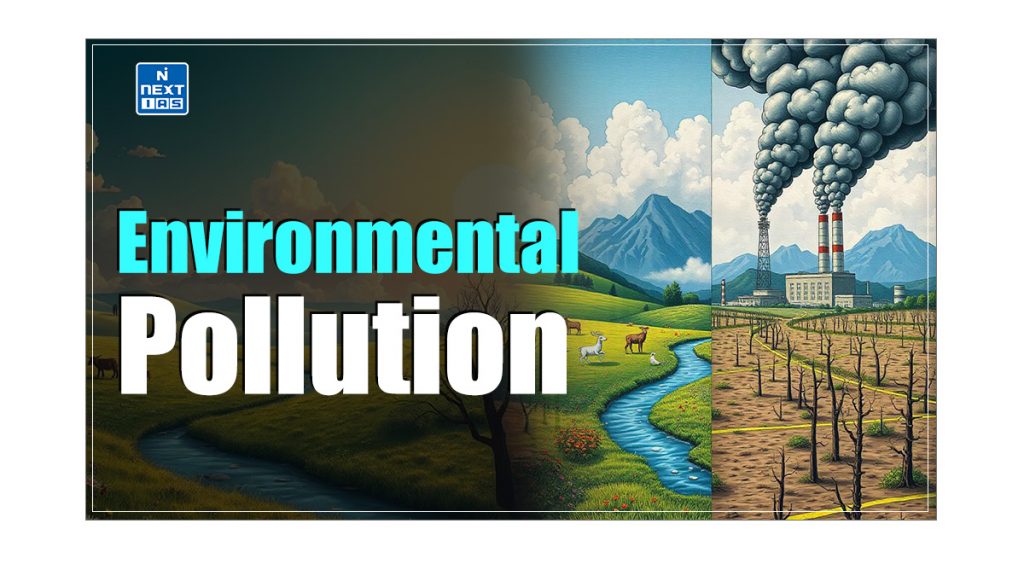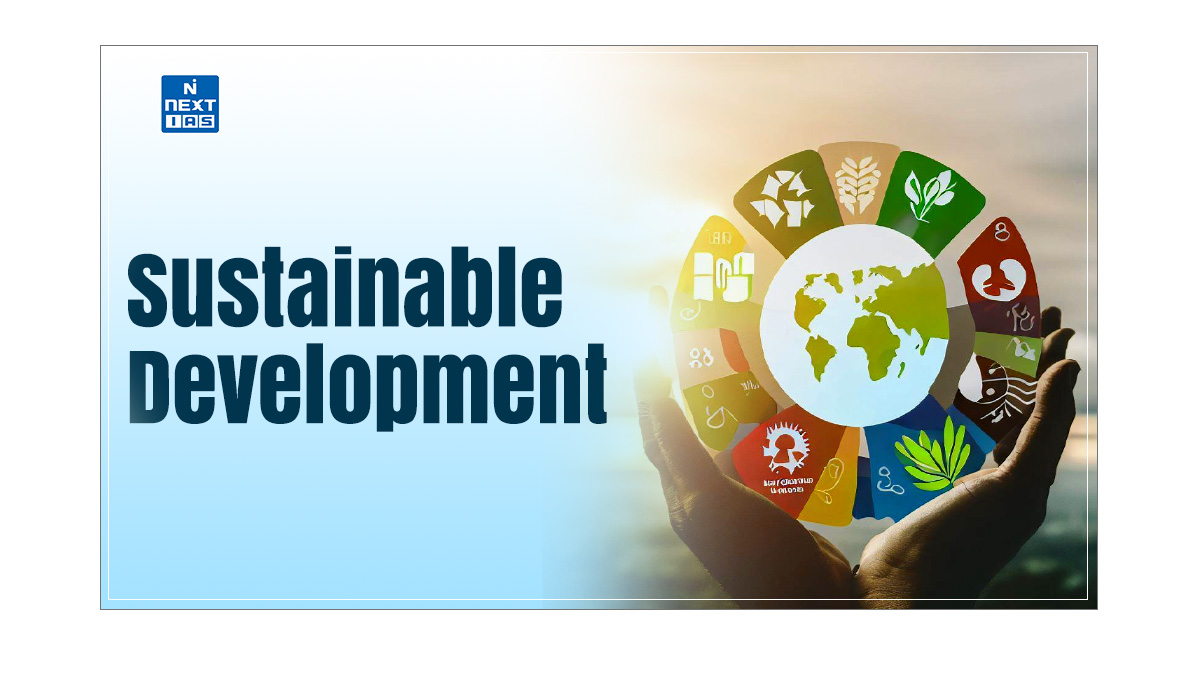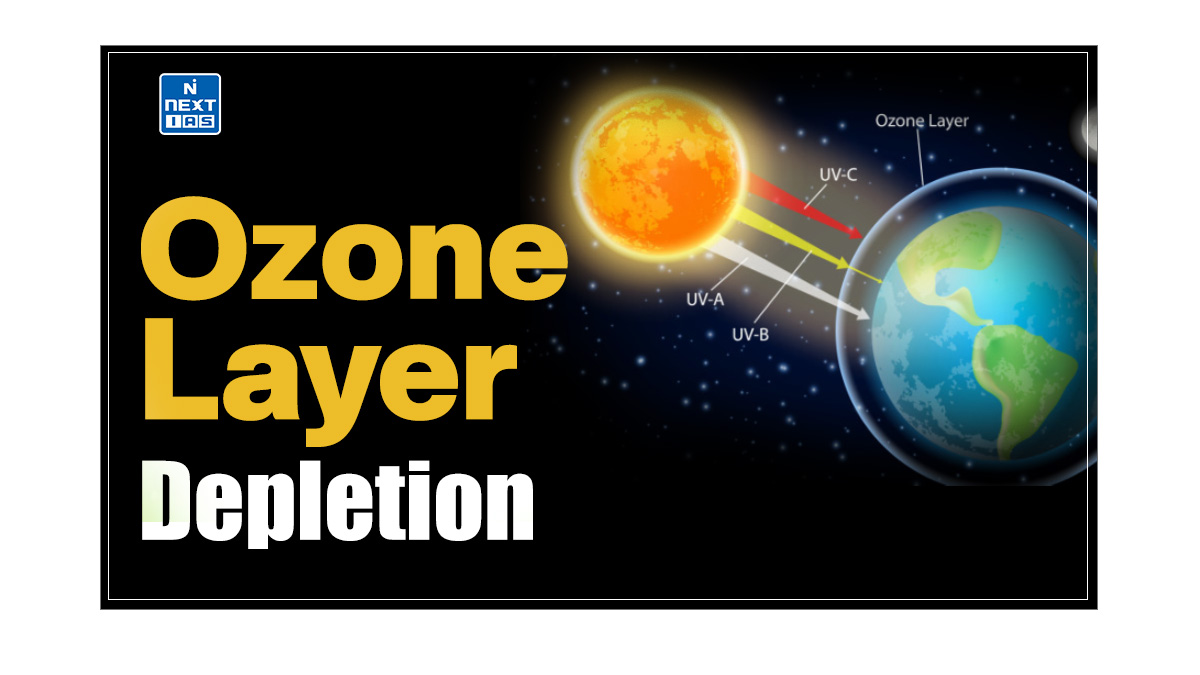
Environmental Pollution has emerged as one of the most pressing challenges of the 21st century. The issue has led to threats to human health, ecosystems, and the overall well-being of our planet. This article aims to study in detail Environmental Pollution, its meaning, types, causes, consequences, and related concepts such as pollutants & their types.
What is Environmental Pollution?
- Environmental Pollution refers to the introduction of harmful materials into the environment.
- In other words, environmental pollution is the contamination of the physical and biological components of the environment to such an extent that normal environmental processes are adversely affected.
Pollutants
- Any harmful material that, by getting introduced into the environment, causes environmental pollution is called a pollutant.
- In other words, a pollutant is any substance that contaminates air, water, soil, etc, and damages their quality.
- Pollutants can be natural, such as volcanic ash, or created by human activity, such as trash or factory runoff.
Types of Pollutants
Pollutants can be categorised into various types based on different parameters, as shown below.
Based on Nature of Disposal
Based on the nature of disposal, pollutants are of the following two types:
Non-Biodegradable Pollutants
- Pollutants that cannot be broken down into simpler, harmless substances in nature are called non-biodegradable pollutants.
- For example, DDT, plastics, polythene, insecticides, pesticides, mercury, lead, arsenic, aluminium cans, synthetic fibres, glass objects, iron products, silver foils, etc.
- Through bioaccumulation and biomagnification, these pollutants may appear in greater concentration as we move along the higher tropics of the food chain.
Biodegradable Pollutants
- Biodegradable Pollutants can be broken down into simpler, harmless substances in nature over time.
- For example, Domestic wastes, urine, faecal matter, sewage, agriculture residues, paper, wood, cloth, cattle dung, animal bones, leather, wool, vegetable stuff or plants etc.
Based on Form of Persistence
Depending upon the form in which they persist after being released into the environment, the pollutants are categorised into the following two types:
Primary Pollutants
- Primary Pollutants are those emitted directly from the source and persist in the environment in the form in which they were added.
- Examples: ash, smoke, fumes, dust, nitric oxide, sulphur dioxide, hydrocarbons, etc.
Secondary Pollutants
- Secondary Pollutants are formed from primary pollutants by chemical interaction with some constituents present in the atmosphere.
- Examples are Sulphur trioxide, nitrogen dioxide, aldehydes, ketones, ozone, etc.
Based on Nature of Pollutants
Depending upon their existence in nature, pollutants are of the following two types:
Quantitative Pollutants
- These substances normally occur in the environment but acquire the status of pollutant when their concentration increases due to human unmindfulness.
- For example, Carbon Dioxide (CO2).
Qualitative Pollutants
- These substances do not usually occur in nature but are added by man.
- For example, insecticides.

Causes of Environmental Pollution
The causes of environmental pollution are based on the following factors:
- Rapid Industrialisation
- The concentration of industries in urban areas releases pollutants into the air, water, and soil, causing environmental pollution.
- The rapid pace of urbanisation also increases waste generation and resource consumption, exacerbating pollution and causing severe environmental pollution.
- Industries also generate hazardous wastes in many forms, including liquids, solids, gases, and sludge.
- Rapid Urbanization
- The increased pace of urbanisation in recent times has led to worsening environmental pollution.
- It creates issues such as deforestation and habitat loss, increased emissions and waste generation, etc.
- Forest Fires
- The frequency of forest fires or wildfires has increased because of human actions, such as land clearing, encroachment, etc.
- These wildfires are a huge source of environmental pollution, adding large amounts of gaseous and other pollutants to the environment.
- Improper Agricultural Practices
- According to the IPCC report, the agriculture sector produces at least 23 per cent of global greenhouse gas emissions (second only to the energy sector).
- Using chemical fertilisers, pesticides, and herbicides in agriculture contributes to soil and water pollution and environmental pollution.
- Intensive farming practices also lead to deforestation, soil erosion, habitat destruction and environmental pollution.
- Deforestation
- Deforestation refers to the decrease in forest areas worldwide that are lost for other uses, such as agricultural croplands, urbanisation, or mining activities.
- This causes an imbalance in the local ecology and reduces nature’s capability to absorb pollutants, leading to environmental pollution.
- Other Causes
- Other prominent causes of environmental pollution include continued reliance on fossil fuels, vehicular emissions, and improper waste management.
Effects of Environmental Pollution
Environmental pollution has severe consequences on human health, ecosystems, and the planet. Below are five key effects:
- Impact on Human Health
Pollution leads to respiratory diseases, cardiovascular problems, and infections. Air pollution causes asthma, lung cancer, and heart disease, while contaminated water results in cholera and gastrointestinal disorders. Exposure to toxic chemicals in soil and food can lead to long-term health risks, including organ damage and developmental issues. - Damage to Ecosystems and Biodiversity
Pollutants harm wildlife and disrupt natural habitats. Water pollution affects aquatic life, leading to fish deaths and loss of marine biodiversity. Airborne toxins damage forests, while soil contamination reduces fertility, affecting plant and animal life. Many species face extinction due to habitat destruction caused by pollution. - Climate Change Acceleration
Air pollution, particularly from greenhouse gases like CO₂ and methane, contributes to global warming. Rising temperatures lead to extreme weather events, glacier melting, rising sea levels, and desertification, affecting both natural and human environments worldwide. - Economic Consequences
Pollution affects industries such as agriculture, fishing, and tourism. Crop yields decline due to soil and air contamination, while polluted water bodies harm fisheries. Increased healthcare costs and loss of productivity due to pollution-related illnesses also burden economies. - Degradation of Quality of Life
Excessive noise, light, and air pollution lower life expectancy and mental well-being. Polluted cities experience reduced visibility, foul odors, and poor living conditions, making daily life uncomfortable and unhealthy for residents.
Types of Environmental Pollution
- Environmental pollution can be categorised into several types based on the nature of the pollutants and the media they affect.
- Some of the major types of environmental pollution are described below.

Air Pollution
- Air Pollution is the contamination of the atmosphere with harmful substances that can adversely affect human health, ecosystems, and climate.
- Air pollution is caused by releasing harmful gases and particulate matter into the atmosphere.
- Significant sources of air pollution include industrial emissions, vehicular exhaust, and burning fossil fuels, which causes environmental pollution.
- Air Pollution is linked to respiratory diseases, cardiovascular problems, and global phenomena like acid rain and climate change.
Read our detailed article on Air Pollution.
Water Pollution
- Water Pollution refers to the contamination of water bodies such as rivers, lakes, and oceans with pollutants such as industrial effluents, sewage, agricultural runoff, and oil spills.
- Water Pollution occurs when pollutants are discharged into water bodies, leading to water quality degradation.
- Industrial effluents, agricultural run-off, and domestic sewage contribute to Water Pollution.
- Contaminated water affects aquatic life, disrupts ecosystems, and poses serious health risks to humans.
Read our detailed article on Water Pollution.
Soil Pollution
- Soil Pollution refers to soil contamination with harmful substances, including heavy metals, pesticides, and industrial waste.
- Major sources of soil pollution include – the deposition of hazardous chemicals, heavy metals, and waste on land.
- Key factors are agricultural practices involving excessive use of pesticides and fertilisers, industrial waste dumping, and improper disposal of solid waste, which also causes environmental pollution.
- Soil pollution reduces soil fertility, contaminates crops, and affects food security.
Read our detailed article on Soil Pollution.
Noise Pollution
- Noise Pollution refers to excessive noise that can adversely affect human health and wildlife.
- Significant contributors to noise pollution include noise from industrial activities, traffic, construction, and urbanisation.
- Chronic exposure to high noise levels can lead to hearing loss, stress, and other health issues, which in turn can lead to environmental pollution.
Read our detailed article on Noise Pollution.
Thermal Pollution
- Thermal Pollution is defined as the sudden increase or decrease in the temperature of a natural body of water, such as an ocean, lake, river, or pond.
- This sudden change in water temperature is mainly due to anthropogenic activities.
- For example, a power plant takes water from a source, such as a river, as a coolant and then discharges the warm water back into the water body.
- Thermal Pollution leads to several issues in the aquatic ecosystem, such as decreased Dissolved Oxygen (DO) levels, algae growth, and a surge in toxins.
Read our detailed article on Thermal Pollution.
Nuclear Pollution or Radiation Pollution
- Nuclear Pollution or Radiation Pollution can be defined as the release of high-energy particles into the air, water or surface.
- It is caused by radioactive materials contaminating the environment by decaying natural or anthropogenic activities.
- Breaches at nuclear power plants, scientific laboratories, chemical spills, etc, are some of the prominent causes of Nuclear Pollution or Radiation Pollution.
- Radiation modifies and destroys cells and genetic materials in living organisms, resulting in ill impacts on health.
Read our detailed article on Nuclear Pollution or Radiation Pollution.
Marine Pollution
- Marine Pollution can be defined as the introduction of substances to the marine environment directly or indirectly by humans, resulting in adverse effects such as hazards to human health, obstruction of marine activities and lowering the quality of seawater.
- Waste and sewage from different sources, such as industries, residences, etc, are directly discharged into the sea and are the primary sources of marine and environmental pollution.
- It affects the flora and fauna of the marine environment.
Read our detailed article on Marine Pollution.
Plastic Pollution
- Plastic pollution is the contamination of the environment with plastic waste, such as discarded plastic items and debris.
- Plastic pollution is a major environmental problem because it takes hundreds of years for plastic to decompose.
- Plastic wastes can accumulate in landfills, waterways, and oceans, causing harm to wildlife and ecosystems.
- Plastic pollution severely impacts the health of humans, wildlife and the overall ecosystem.
Read our detailed article on Plastic Pollution.
Light Pollution
- Light Pollution refers to excessive artificial light that can disrupt ecosystems and nocturnal activities.
- Over-illumination in urban areas disrupts natural light cycles, affecting wildlife and human health.
- It contributes to energy waste and interferes with astronomical observations.
Consequences of Environmental Pollution
The consequences of environmental pollution are as follows:
- Public Health
- Pollution is a significant cause of diseases and premature deaths globally.
- Different types of pollution have different impacts on human health.
- Air pollution alone is responsible for millions of deaths annually, with children and the elderly being particularly vulnerable.
- Environmental Degradation
- Pollution disrupts ecosystems, leading to the loss of biodiversity, degradation of natural habitats, and alteration of ecological processes.
- All these, in turn, lead to issues such as disruption of food chains and environmental pollution.
- Climate Change
- Pollution, particularly from greenhouse gas emissions, is a significant driver of climate change.
- This, in turn, leads to issues such as global warming, more frequent and severe weather events, rising sea levels, and shifts in ecosystems.
- Economic Costs
- The economic burden of pollution is immense, including loss of productivity and ecosystem damage.
- The expenses on environmental pollution control measures and increased healthcare costs also add to the economic costs of pollution.
- The economic burden of pollution is immense, including loss of productivity and ecosystem damage.
- Social Impacts
- Pollution can reduce overall quality of life by affecting people’s health, well-being, and enjoyment of their environment.
- Environmental degradation and its associated consequences, such as droughts, water crises, etc, can cause social unrest and conflicts, forced displacement of communities, etc.
Suggested Measures for Addressing Environmental Pollution
To mitigate the effects of environmental pollution, a comprehensive and multi-faceted approach is necessary, including:
- Policy and Regulation: Governments must implement strict environmental regulations to limit emissions, control waste, and promote sustainable practices.
- Public Awareness and Education: It is crucial to tackle pollution by educating the public about the causes and consequences of pollution and encouraging environmentally responsible behaviour.
- Sustainable Practices: Promoting sustainable consumption patterns and resource management.
- The principles of the circular economy, which emphasise recycling and reusing resources, should be widely adopted.
- Technological Solutions: Innovations in clean energy, waste management, and pollution control technologies can significantly reduce human activities’ environmental footprint.
- International Cooperation: Environmental pollution is a transboundary issue that requires coordinated international efforts.
- Through treaties, conventions, and collaborative initiatives, global cooperation is essential for addressing environmental pollution globally.
Conclusion
Environmental pollution poses a significant threat to the health of our planet and its inhabitants. As a challenge transcending national boundaries, it requires a collective effort from governments, industries, and individuals to implement sustainable solutions. By adopting a holistic approach and taking immediate action, we can protect our planet for future generations and ensure a sustainable future.
FAQs
What are the different types of Pollution?
Pollution is the contamination of the environment by harmful substances. Major types include air pollution (toxic gases, smoke), water pollution (industrial waste, plastics), soil pollution (pesticides, chemicals), noise pollution (traffic, machinery), thermal pollution (heat from industries), and light pollution (excessive artificial lighting), all impacting health and ecosystems.
Read this article in Hindi: पर्यावरण प्रदूषण
GS - 3





